Do you have only a few moles and are wondering if it’s worth it to check every month for signs of melanoma?
Perhaps you’re supposing that your risk of melanoma is lower because you have only three moles.
• About one-third of melanomas arise in a pre-existing mole.
• The risk for melanoma is higher in people with more than 100 moles.
• Melanoma can arise in a mole that’s located in an area that’s had no sun exposure.
Being that 100 moles is about the cutoff after which the risk increases, you may be wondering about the risk in people with 50 moles vs. five moles.
“It is always recommended to check for melanoma if you have any moles, even if you only have a few,” says Alpana Mohta, MD, DNB, a dual board certified dermatologist who specializes in clinical and aesthetic dermatology.
“Melanoma, the most serious type of skin cancer, can develop in any mole, regardless of how many you have.
“Early detection of melanoma is crucial for successful treatment, as it is more likely to spread to other parts of the body if not caught early on.”
Melanoma commonly metastasizes to the lungs and brain, though can also migrate to other sites.
Dr. Mohta continues, “While it is normal to have moles on your skin, it is important to monitor them for any changes in size, shape, color or texture.
“These changes can be a sign of melanoma and should be brought to the attention of a healthcare provider.
“Additionally, certain individuals may be at a higher risk for developing melanoma.
“This includes those with a family history of melanoma, a weakened immune system or a history of excessive sun exposure.
“These individuals should be especially vigilant in checking for melanoma, even if they only have a few moles.
“Furthermore, regular skin checks by a healthcare provider can help identify potential melanomas at an early stage.
“A healthcare provider can evaluate your moles and determine if any of them should be removed or biopsied for further testing.”
The evaluation should include the use of a handheld light and magnification instrument called a dermatoscope.
Have only one or two moles? Dr. Mohta says you should be just as consistent and conscientious about checking these as you would if you had 50 moles.
But there’s another point that needs to be made – whether you have just a few moles or dozens.
You should also examine all of your skin; not just the moles. Remember, only about 30 percent of melanomas arise in pre-existing moles.
However, an early melanoma that’s growing de novo – that is, in the absence of a pre-existing mole – may actually look very much like a common mole.
What may appear to be a new mole, freckle or sunspot will have dynamic changes over a period of several months if it’s melanoma.
If you’re over 40, have only a few moles or many, but then one day discover a new “mole,” you should promptly have a dermatologist inspect it with a dermatoscope.
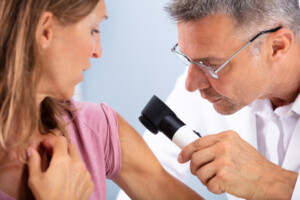
Shutterstock/Andrey_Popov
It won’t necessarily be cancerous, as it could be an innocent lentigo or sunspot. However, early melanoma is highly curable.
“Early detection is crucial for successful treatment, and regular skin checks by a healthcare provider can help identify potential melanomas,” says Dr. Mohta.
“If you have any concerns about your moles, be sure to speak with your healthcare provider.”
Pictures of Melanoma: the Many Shapes and Colors
Below are images of melanoma. All suspicious-looking pigmented lesions should be removed for a biopsy.
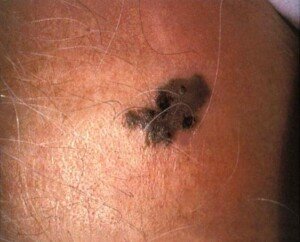
3 CDC, Carl Washington, MD, Emory Univ. School of Medicine, Mona Saraiya, MD, MPH
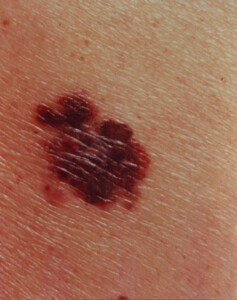
Laurence Meyer, MD. cancer.gov
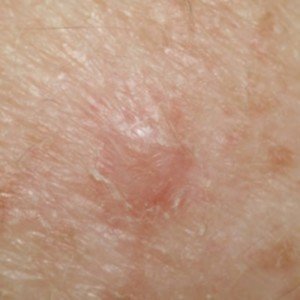
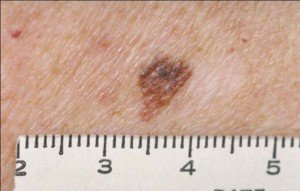
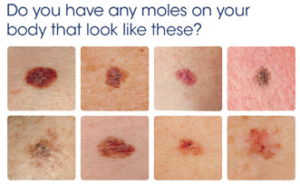
Dr. Alpana explains five things you should know about melanoma.
 Dr. Alpana Mohta is a dual board certified dermatologist and owner of dralpana.com. Her areas of interest include clinical dermatology, dermatopathology and dermatosurgery. She has over 85 research publications in numerous journals. Apart from her regular medical practice, she is also a medical writer, reviewer and advisor for many companies.
Dr. Alpana Mohta is a dual board certified dermatologist and owner of dralpana.com. Her areas of interest include clinical dermatology, dermatopathology and dermatosurgery. She has over 85 research publications in numerous journals. Apart from her regular medical practice, she is also a medical writer, reviewer and advisor for many companies.
 Lorra Garrick has been covering medical, fitness and cybersecurity topics for many years, having written thousands of articles for print magazines and websites, including as a ghostwriter. She’s also a former ACE-certified personal trainer.
Lorra Garrick has been covering medical, fitness and cybersecurity topics for many years, having written thousands of articles for print magazines and websites, including as a ghostwriter. She’s also a former ACE-certified personal trainer.
.










































